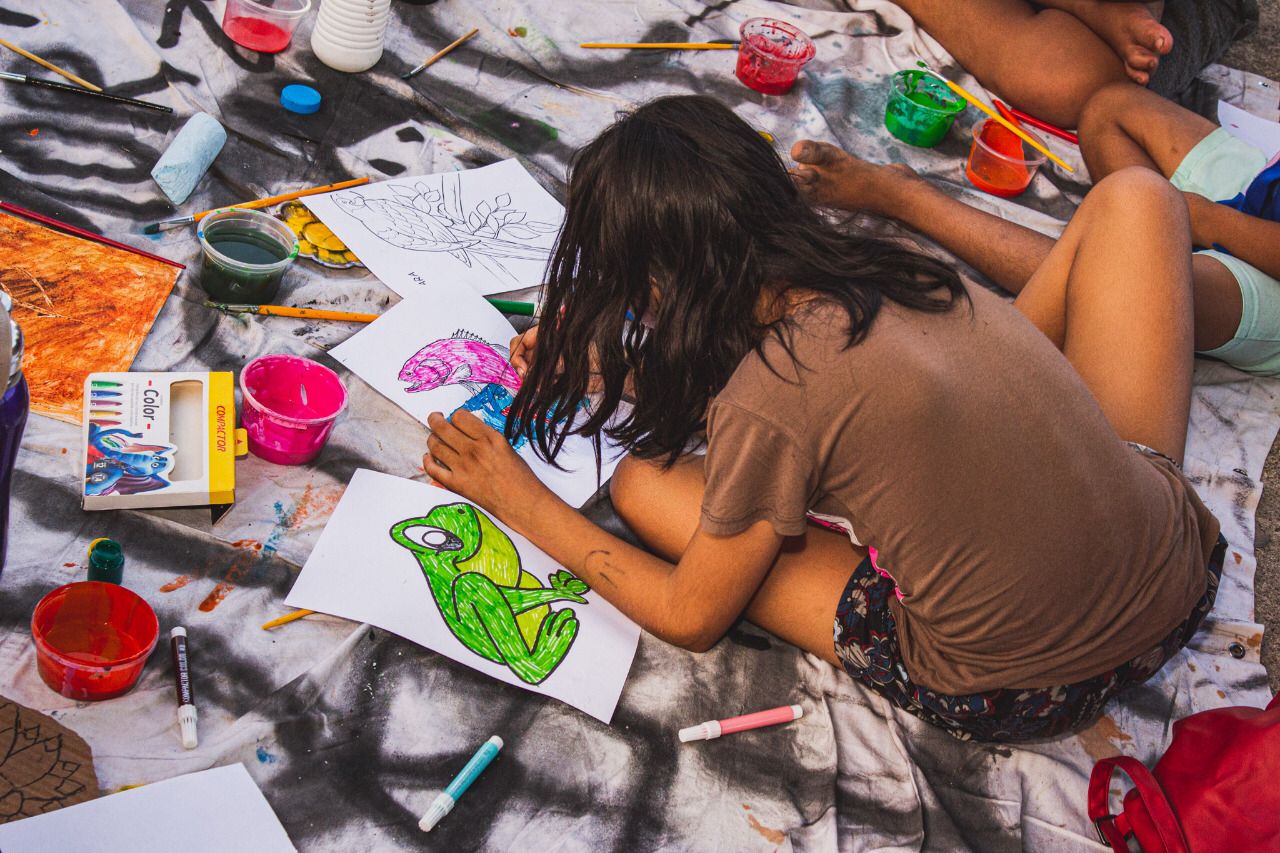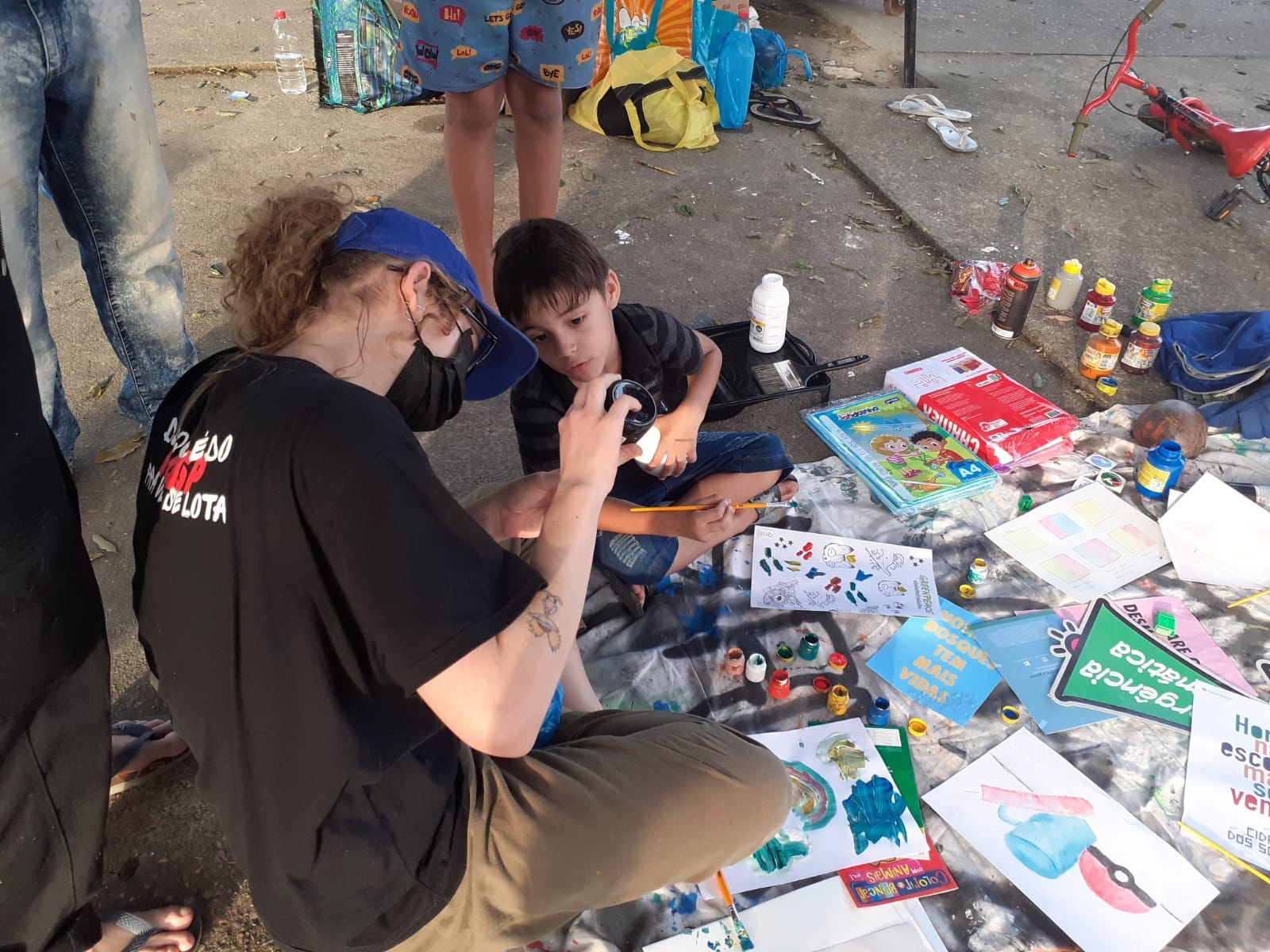“Arte Ocupa” project in Manaus has spread art on the outskirts of the capital
Discussing the real space of art with paper and paint in the squares, the project has attracted the eyes of children and parents


Credit: Disclosure
By: Alicia Lobato – Lupa do Bem / Favela em Pauta
Created in 2021, in the neighborhood of Petrópolis, south of Manaus, the Arte Ocupa project started with a simple premise: bringing painting material to the squares of the neighborhoods and involving the people there. However, what the group did not expect was that it would conquer a specific and very creative audience: Children.
From the restlessness with university life to the desire to see art beyond the classroom, this is how Arte Ocupa was born. The project, which has three organizers, Sarah Campelo, Anderson Souza and Marcelo Rufi – all residents of peripheral neighborhoods of Manaus, Amazonas – began only as a way of occupying spaces in the capital with contemporary art, but after a year it was consolidated as an organization that has contributed to the training of children and adults in neighborhoods of the city.
With the presence of the children, the parents also developed an interest for the project. The collective was strengthened and installed in the neighborhood of one of the creators, Sarah Campelo, a student of visual arts at the Federal University of Amazonas. For Sarah, the acceptance of the project and the presence of the children’s audience was a surprise:
“It was organic, we took paper and the children painted. There’s a grandiosity around it, it’s a time when kids have fun, they feel important, creative.” The student says that she did not expect that Arte Ocupa would grow so much in one year and that they were not aiming for recognition, “we just wanted to make art, without limitations within the university and now there are collectives that want to work with us, people”.
From scarcity, Arte Ocupa makes a difference in the periphery
The lack of outdoor activities for children on the outskirts of the capital was one of the reasons why the project became an attraction in the neighborhood. The relationship that was formed was one of cultural exchange, with children from the neighborhood who did not know each other and became friends through the project. And with the growth, there was also the need to strengthen the collective, aiming to guide other subjects along with the children, either through the use of recyclable material or suggesting themes such as the environment for them to express what they understand about the subject through drawings.

According to another member of the collective, Anderson, the space has become an environment where children feel free not only to play, but also to ask, learn and teach. He adds: “It brought a difference to the neighborhood, the child plays, is playing ball – when something different like this is inserted, it changes what is normal for them, and they become more connected with each other. The parents also got to know each other, and they expressed themselves more”.
Anderson joined the project after it had already started. He says that he met the collective through the university, and his interest arose immediately: “what caught my attention was that they took the time to go to the square where the children went, and provide a place where they could have fun. The experience of each of them is very different from the others, so it is important to value their way of thinking and have a place where they can go and learn about art”.
With the high demand for activities, the event that did not have a certain date began to be planned to take place monthly. With this recognition, other opportunities also emerged. In June, the collective was present at an event in the east of the city, bringing the theme “environment” to the periphery. There, the project managed to attract the attention of children and, quickly, adults also expressed interest in taking Arte Ocupa to their neighborhoods.
For Marcelo Ruffi, one of the creators of the actions, the artistic scene in Manaus suffers from the absence of projects in the field of arts and other activities that could change the peripheral reality.
“The community does what it can naturally, trying to do its best in the midst of adversity and trying to make things happen. Every initiative must be celebrated. I see that the local government still establishes its public policies in the center of the city or areas where there is a great appeal for visibility, leaving entire neighborhoods without leisure options.” Marcelo remembers a phrase by pedagogue Rita André: “It takes a village to educate a child.” For the visual arts student, educators and artists are just one part of this process, which must include more actors.
Art as work: Members need to make it possible to maintain the project
In Petrópolis, the main audience are the children of the merchants who work in the square. Sarah observed the project, then, as a counterpart of the space where they live: “we started having conversations about how the space in which we live shapes us, and we thought about this lack of artistic projects in the periphery”. Today, her own parents send messages to her, asking when the collective’s next action will be.


Sarah’s main dream for the project is for it to also become the team’s means of work. Today, the material used in the activities is bought with the members’ own money, but she explains that the actions have also received donations from project admirers, who contribute with ink and paper.
Marcelo mentions their desire to expand: “I see the project in other spaces and with new audiences, who start having the Arte Ocupa experience. And, who knows, even a studio with physical space for us to produce, exhibit and store our productions”, he adds.
Follow Arte Ocupa on Instagram
The Arte Ocupa project concentrates its presence on the networks through instagram, where it is possible to know more about the collective and follow the work: @arteocupa


